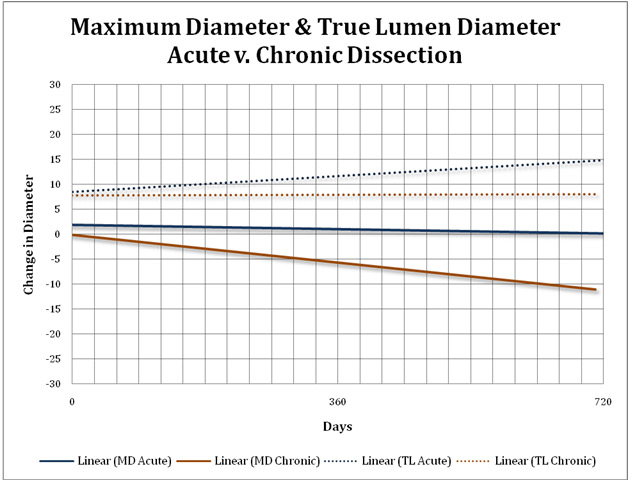|
Back to Annual Symposium Program
Aortic Remodeling following TEVAR in Acute and Chronic Type B Dissection
Woodrow J. Farrington, James B. Sampson, MD, Marjan Mujib, MD, MPH, Marc A. Passman, MD, Mark A. Patterson, MD, Steve M. Taylor, MD, Thomas C. Matthews, MD, William D. Jordan, Jr., MD.
University of Alabama at Birmingham, Birmingham, AL, USA.
OBJECTIVES:
To determine the changes in aortic luminal diameter for patients with acute and chronic aortic dissection.
METHODS:
Patients treated with TEVAR for type B aortic dissection (AD) were identified from a prospectively maintained registry. Health systems charts, medical correspondence and computed tomography (CT) imaging were reviewed. Measurements for true lumen (TL) and false lumen diameters were recorded at the first transverse section directly inferior to the aortic arch. Maximum diameter (MD) was recorded at the point of maximal dilation regardless of position. Data were analyzed for up to 2 years following endovascular intervention.
RESULTS:
Of 52 patients treated with TEVAR for AD, pre and 2 year post op CT was available for analysis and comparison in 30 patients. Fourteen patients (47%) were treated within 14 days of dissection (acute), while 16 patients (53%) were after 14 days (chronic). Indications for treatment were malperfusion (5 - 16.7%), expansion (10 - 33.3%), pain (8 - 26.7%), and uncontrolled hypertension (7 - 23.3%). For all patients at 2 years, MD decreased by a mean of 2.1 mm while TL increased by a mean of 12.7 mm. Overall, 19 patients (63%) had a decrease in MD and 26 patients (87%) had an increase in TL. Subgroup analysis revealed the following: patients treated in the acute period, MD decreased an average of 1.8 mm while TL increased an average of 9.8 mm. For those treated for chronic dissection, MD decreased an average of 4.1 mm while TL increased an average of 15 mm.
CONCLUSIONS:
TEVAR shows stabilization and positive remodeling of both acute and chronic type B aortic dissection evident by both decreasing maximum diameter and increasing the true lumen.

Back to Annual Symposium Program

|


